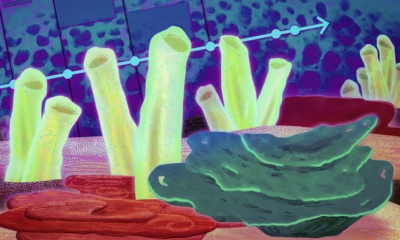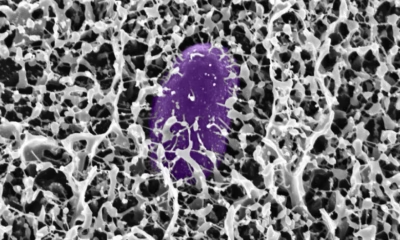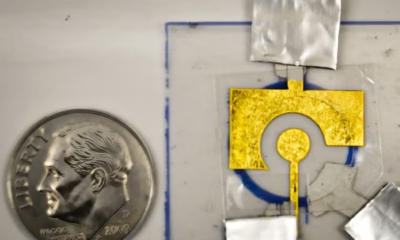Space & Physics
What brought carbon to Earth
This marks the first time a complex form of carbon essential for life on Earth has been observed outside the solar system. To learn more about the significance of this discovery, EdPublica interviewed the researchers behind the study– Gabi Wenzel, Ilsa Cooke, and Brett McGuire, who shared their insights on the implications of pyrene’s presence in space and its potential impact on our understanding of star and planet formation
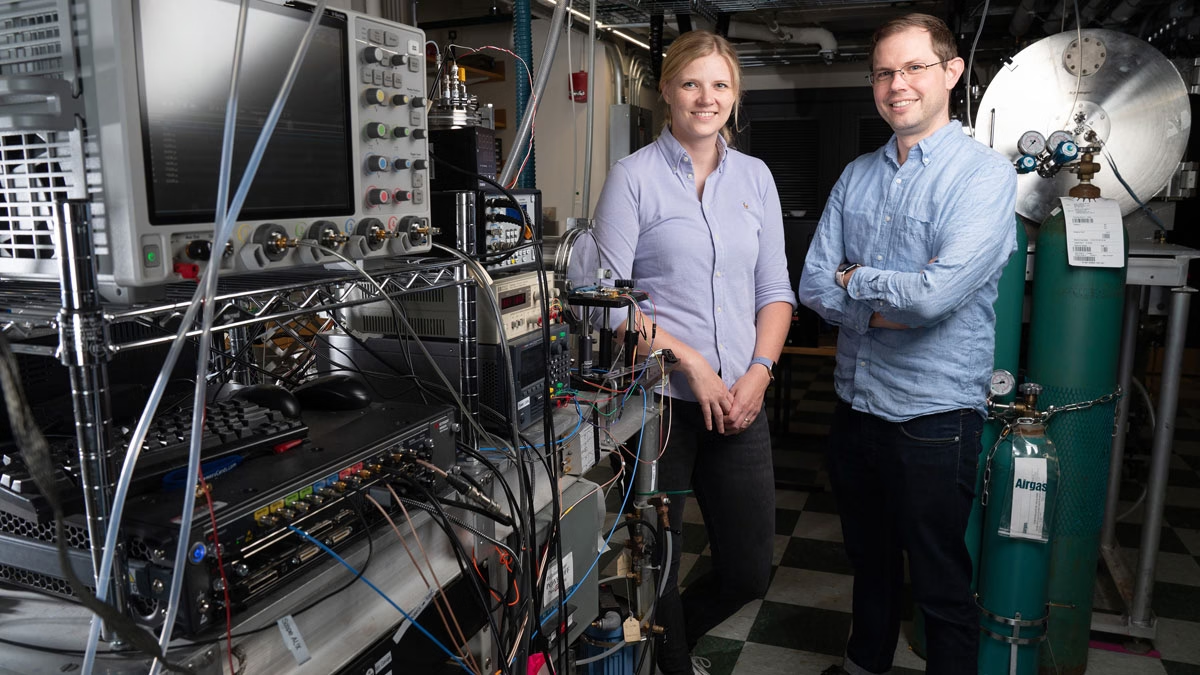
A team led by researchers at MIT has detected pyrene, a complex carbon-containing molecule, in a distant interstellar cloud. This finding opens new avenues for understanding the chemical origins of our solar system. Pyrene, a type of polycyclic aromatic hydrocarbon (PAH), was found in a molecular cloud similar to the one from which our solar system formed.
This marks the first time a complex form of carbon essential for life on Earth has been observed outside the solar system. Its discovery sheds light on how the compounds necessary for life could originate in space. The team detected pyrene in
a star-forming region known as the Taurus Molecular Cloud, located 430 light-years away, making it one of the closest such clouds to Earth.
This discovery also aligns with recent findings from the asteroid Ryugu, suggesting that pyrene may have played a key role in the carbon composition of the early solar system. To learn more about the significance of this discovery, EdPublica interviewed the researchers behind the study– Gabi Wenzel, Ilsa Cooke, and Brett McGuire, who shared their insights on the implications of pyrene’s presence in space and its potential impact on our understanding of star and planet formation. Brett McGuire is an assistant professor of chemistry at MIT, Ilsa Cooke is an assistant professor of chemistry at the University of British Columbia, and Gabi Wenzel is a postdoctoral researcher in McGuire’s group at MIT.
Below, the team responds to questions from EdPublica Editor Dipin Damodharan about this unexpected and exciting discovery.
‘Pyrene could be a major source of carbon in our solar system’
Q: How does the discovery of pyrene in TMC-1 enhance our understanding of the chemical inventory that contributed to the formation of our solar system?
Gabi Wenzel:
Stars much like our own sun are born from dense molecular clouds. The discovery of pyrene in a molecular cloud called TMC-1, one that might be very similar to our sun’s natal cloud and which will go on to form a star of its own, significantly enhances our understanding of the chemical inventory that contributed to the formation of our own solar system. As a polycyclic aromatic hydrocarbon (PAH), pyrene is one of the most complex organic molecules found in early molecular clouds, suggesting that the building blocks of organic matter were available in the environments where stars and their orbiting (exo)planets form.

This discovery sheds light on the chemical processes occurring in interstellar space, including gas-phase and surface reactions on dust grains, which are crucial for the evolution of organic chemistry. This further supports the notion that the primordial materials of our solar system contained a diverse range of organic compounds, providing insights into the potential for prebiotic chemistry on a young Earth and planetesimals.
Q: What specific challenges did you face in detecting pyrene, given that it is invisible to traditional radio astronomy methods, and how did the use of cyanopyrene help overcome these challenges?
Gabi Wenzel:
Pyrene, a fully symmetric PAH, does not possess a permanent electric dipole moment and hence is invisible in radio astronomical observations or rotational spectrometers in the laboratory. The CN radical is highly abundant in the cold and dark molecular cloud TMC-1, an environment that is about 10 K cold and in which you’d assume little chemistry to happen. However, earlier experimental works have shown that the CN addition (followed by hydrogen abstraction) to ringed hydrocarbon species such as benzene and toluene at low temperatures is a barrierless process.
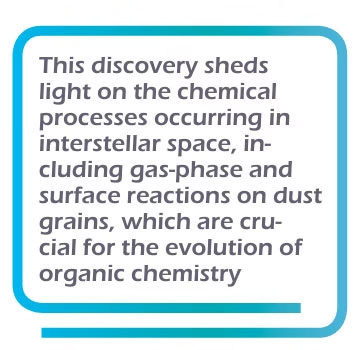
Adding a CN (nitrile) group to a hydrocarbon will drastically increase its permanent electric dipole moment and so allow rotational transitions. Indeed, several CN-functionalized species have been detected in TMC-1 and other sources, among which the CN-substituted benzene (cyanobenzene or benzonitrile) and other smaller PAHs, with cyanopyrene being the largest molecule found via radio astronomy to date, allowing us to infer the presence of pyrene itself.
Q: Can you elaborate on what it means for our understanding of carbon sources in the solar system that pyrene is found in both TMC-1 and asteroid Ryugu?
Ilsa Cooke:
TMC-1 is a famous example of a cold molecular cloud, one of the earliest stages of star and planet formation, while asteroids like Ryugu represent snapshots of later stages in the formation of solar systems. Asteroids are formed from material in the solar nebula that was inherited from the molecular cloud stage. Our radio observations of TMC-1 let us observe pyrene early on and possibly under conditions where it is first forming. Isotope signatures of the pyrene in Ryugu suggest it was formed in a cold interstellar cloud. From these two unique sets of measurements, we can start to unravel the inheritance of pyrene, and PAHs more generally, from their birth in interstellar space and their journey to new planets. If PAHs can survive all the way from the molecular cloud stage, they may provide planets with an important source of organic carbon.

Q: What are the different formation routes of PAHs that your research suggests, and how do these differ from previous hypotheses about PAH formation in space?
Ilsa Cooke:
Our results, combined with those of Zeichner et al., who measured pyrene in Ryugu, suggest that pyrene may form at low temperatures by “bottom-up” routes in molecular clouds. Previously, PAHs were most commonly associated with formation in high-temperature (ca. 1000 K) environments in the envelopes of dying stars. These stars are thought to eject their PAHs, along with other carbon-rich molecules, into the diffuse interstellar medium.
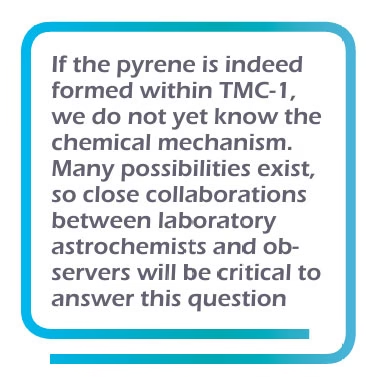
However, the diffuse medium is a tenuous, harsh environment permeated by ultraviolet photons, and most astrochemists think that small PAHs would not survive their journey through the diffuse medium into dense molecular clouds. So we are still left with a puzzle: does that pyrene that we observe in TMC-1 form there, or was it formed somewhere else but it was able to survive its journey more efficiently than previously thought? If the pyrene is indeed formed within TMC-1, we do not yet know the chemical mechanism. Many possibilities exist, so close collaborations between laboratory astrochemists and observers will be critical to answer this question.

Q: What are your plans for investigating larger PAH molecules in TMC-1, and what specific hypotheses are you looking to test with these investigations?
Brett McGuire:
We have a number of other targets lined up – again focusing on PAH structures that should show this special stability demonstrated by pyrene. They present the same experimental challenges, including needing to devise appropriate synthetic routes in the laboratory before collecting their spectra. The major question is just how complex the PAH inventory actually gets at this earliest stage of star formation.

Prior to our work in TMC-1, nearly everything we knew about PAHs came from infrared observations of bulk properties in much warmer and more energetic regions, where PAHs are thought to be much larger. Does the population in TMC-1 look the same as in these regions? Is it at an earlier stage of chemical evolution? And how does this distribution compare to what we see in our own Solar System?

Q: How do your findings about pyrene and PAHs in interstellar clouds influence our broader understanding of organic chemistry in the universe, particularly in relation to the origins of life?
Brett McGuire:
Life as we know it depends on carbon – it is the backbone upon which all our molecular structures are constructed. Yet, the Earth overall is somewhat depleted in carbon relative to what we’d naively expect, and we still don’t fully understand where the carbon we do have came from originally. PAHs in general seem to be a massive reservoir of reactive carbon, and what we are now seeing is that that reservoir is already present at the earliest stages of star-formation. Combined with the evidence from Ryugu, we’re now also seeing indications that the inventory of PAHs, and thus this reservoir of carbon, may actually survive from this dark molecular cloud phase through the formation of a star to be eventually incorporated into the planetary system itself.
Space & Physics
Physicists Double Precision of Optical Atomic Clocks with New Laser Technique
MIT researchers develop a quantum-enhanced method that doubles the precision and stability of optical atomic clocks, paving the way for portable, ultra-accurate timekeeping.

MIT physicists have unveiled a new technique that could significantly improve the precision and stability of next-generation optical atomic clocks, devices that underpin everything from mobile transactions to navigation apps. In a recent media statement, the MIT team explained: “Every time you check the time on your phone, make an online transaction, or use a navigation app, you are depending on the precision of atomic clocks. An atomic clock keeps time by relying on the ‘ticks’ of atoms as they naturally oscillate at rock-steady frequencies.”
Current atomic clocks rely on cesium atoms tracked with lasers at microwave frequencies, but scientists are advancing to clocks based on faster-ticking atoms like ytterbium, which can be tracked with lasers at higher, optical frequencies and discern intervals up to 100 trillion times per second.
A research group at MIT, led by Vladan Vuletić, the Lester Wolfe Professor of Physics, detailed that their newly developed method harnesses a laser-induced “global phase” in ytterbium atoms and boosts this effect using quantum amplification. Vuletić stated, “We think our method can help make these clocks transportable and deployable to where they’re needed.” The approach, called global phase spectroscopy, doubles the precision of an optical atomic clock, enabling it to resolve twice as many ticks per second compared to standard setups, and promises further gains with increasing atom counts.
The technique could pave the way for portable optical atomic clocks able to measure all manner of phenomena in various locations. Vuletić summarized the broader scientific ambitions: “With these clocks, people are trying to detect dark matter and dark energy, and test whether there really are just four fundamental forces, and even to see if these clocks can predict earthquakes.”
The MIT team has previously demonstrated improved clock precision by quantumly entangling hundreds of ytterbium atoms and using time reversal tricks to amplify their signals. Their latest advance applies these methods to much faster optical frequencies, where stabilizing the clock laser has always been a major challenge. “When you have atoms that tick 100 trillion times per second, that’s 10,000 times faster than the frequency of microwaves,” said Vuletić in the statement. Their experiments revealed a surprisingly useful “global phase” information about the laser frequency, previously thought irrelevant, unlocking the potential for even greater accuracy.
The research, led by Vuletić and joined by Leon Zaporski, Qi Liu, Gustavo Velez, Matthew Radzihovsky, Zeyang Li, Simone Colombo, and Edwin Pedrozo-Peñafiel of the MIT-Harvard Center for Ultracold Atoms, was published in Nature. They believe the technical benefits of the new method will make atomic clocks easier to run and enable stable, transportable clocks fit for future scientific exploration, including earthquake prediction, fundamental physics, and global time standards.
Space & Physics
Nobel Prize in Physics: Clarke, Devoret, and Martinis Honoured for Pioneering Quantum Discoveries
The 2025 Nobel Prize in Physics honours John Clarke, Michel H. Devoret, and John M. Martinis for revealing how entire electrical circuits can display quantum behaviour — a discovery that paved the way for modern quantum computing.

The 2025 Nobel Prize in Physics has been awarded to John Clarke, Michel H. Devoret, and John M. Martinis for their landmark discovery of macroscopic quantum mechanical tunnelling and energy quantisation in an electric circuit, an innovation that laid the foundation for today’s quantum computing revolution.
Announcing the prize, Olle Eriksson, Chair of the Nobel Committee for Physics, said, “It is wonderful to be able to celebrate the way that century-old quantum mechanics continually offers new surprises. It is also enormously useful, as quantum mechanics is the foundation of all digital technology.”
The Committee described their discovery as a “turning point in understanding how quantum mechanics manifests at the macroscopic scale,” bridging the gap between classical electronics and quantum physics.
John Clarke: The SQUID Pioneer
British-born John Clarke, Professor Emeritus at the University of California, Berkeley, is celebrated for his pioneering work on Superconducting Quantum Interference Devices (SQUIDs) — ultra-sensitive detectors of magnetic flux. His career has been marked by contributions that span superconductivity, quantum amplifiers, and precision measurements.
Clarke’s experiments in the early 1980s provided the first clear evidence of quantum behaviour in electrical circuits — showing that entire electrical systems, not just atoms or photons, can obey the strange laws of quantum mechanics.
A Fellow of the Royal Society, Clarke has been honoured with numerous awards including the Comstock Prize (1999) and the Hughes Medal (2004).
Michel H. Devoret: Architect of Quantum Circuits
French physicist Michel H. Devoret, now the Frederick W. Beinecke Professor Emeritus of Applied Physics at Yale University, has been one of the intellectual architects of quantronics — the study of quantum phenomena in electrical circuits.
After earning his PhD at the University of Paris-Sud and completing a postdoctoral fellowship under Clarke at Berkeley, Devoret helped establish the field of circuit quantum electrodynamics (cQED), which underpins the design of modern superconducting qubits.
His group’s innovations — from the single-electron pump to the fluxonium qubit — have set performance benchmarks in quantum coherence and control. Devoret is also a recipient of the Fritz London Memorial Prize (2014) and the John Stewart Bell Prize, and is a member of the French Academy of Sciences.
John M. Martinis: Building the Quantum Processor
American physicist John M. Martinis, who completed his PhD at UC Berkeley under Clarke’s supervision, translated these quantum principles into the hardware era. His experiments demonstrated energy level quantisation in Josephson junctions, one of the key results now honoured by the Nobel Committee.
Martinis later led Google’s Quantum AI lab, where his team in 2019 achieved the world’s first demonstration of quantum supremacy — showing a superconducting processor outperforming the fastest classical supercomputer on a specific task.
A former professor at UC Santa Barbara, Martinis continues to be a leading voice in quantum computing research and technology development.
A Legacy of Quantum Insight
Together, the trio’s discovery, once seen as a niche curiosity in superconducting circuits, has become the cornerstone of the global quantum revolution. Their experiments proved that macroscopic electrical systems can display quantised energy states and tunnel between them, much like subatomic particles.
Their work, as the Nobel citation puts it, “opened a new window into the quantum behaviour of engineered systems, enabling technologies that are redefining computation, communication, and sensing.”
Space & Physics
The Tiny Grip That Could Reshape Medicine: India’s Dual-Trap Optical Tweezer
Indian scientists build new optical tweezer module—set to transform single-molecule research and medical Innovation

In an inventive leap that could open up new frontiers in neuroscience, drug development, and medical research, scientists in India have designed their own version of a precision laboratory tool known as the dual-trap optical tweezers system. By creating a homegrown solution to manipulate and measure forces on single molecules, the team brings world-class technology within reach of Indian researchers—potentially igniting a wave of scientific discoveries.
Optical tweezers, a Nobel Prize-winning invention from 2018, use focused beams of light to grab and move microscopic objects with extraordinary accuracy. The technique has become indispensable for measuring tiny forces and exploring the mechanics of DNA, proteins, living cells, and engineered nanomaterials. Yet, decades after their invention, conventional optical tweezers systems sometimes fall short for today’s most challenging experiments.
Researchers at the Raman Research Institute (RRI), an autonomous institute backed by India’s Department of Science and Technology in Bengaluru, have now introduced a smart upgrade that addresses long-standing pitfalls of dual-trap tweezers. Traditional setups rely on measuring the light that passes through particles trapped in two separate beams—a method prone to signal “cross-talk.” This makes simultaneous, independent measurement difficult, diminishing both accuracy and versatility.
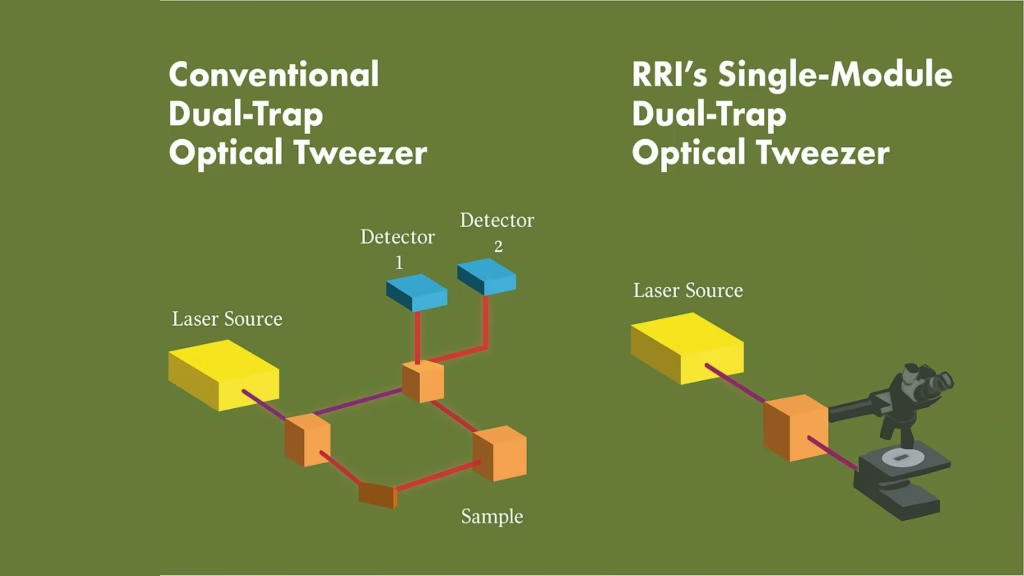
The new system pioneers a confocal detection scheme. In a media statement, Md Arsalan Ashraf, a doctoral scholar at RRI, explained, “The unique optical trapping scheme utilizes laser light scattered back by the sample for detecting trapped particle position. This technique pushes past some of the long-standing constraints of dual-trap configurations and removes signal interference. The single-module design integrates effortlessly with standard microscopy frameworks,” he said.
The refinement doesn’t end there. The system ensures that detectors tracking tiny particles remain perfectly aligned, even when the optical traps themselves move. The result: two stable, reliable measurement channels, zero interference, and no need for complicated re-adjustment mid-experiment—a frequent headache with older systems.
Traditional dual-trap designs have required costly and complex add-ons, sometimes even hijacking the features of laboratory microscopes and making additional techniques, such as phase contrast or fluorescence imaging, hard to use. “This new single-module trapping and detection design makes high-precision force measurement studies of single molecules, probing of soft materials including biological samples, and micromanipulation of biological samples like cells much more convenient and cost-effective,” said Pramod A Pullarkat, lead principal investigator at RRI, in a statement.
By removing cross-talk and offering robust stability—whether traps are close together, displaced, or the environment changes—the RRI team’s approach is not only easier to use but far more adaptable. Its plug-and-play module fits onto standard microscopes without overhauling their basic structure.
From the intellectual property point of view, this design may be a game-changer. By cracking the persistent problem of signal interference with minimalist engineering, the new setup enhances measurement precision and reliability—essential advantages for researchers performing delicate biophysical experiments on everything from molecular motors to living cells.
With the essential building blocks in place, the RRI team is now exploring commercial avenues to produce and distribute their single-module, dual-trap optical tweezer system as an affordable add-on for existing microscopes. The innovation stands to put advanced single-molecule force spectroscopy, long limited to wealthier labs abroad, into the hands of scientists across India—and perhaps spark breakthroughs across the biomedical sciences.
-

 Space & Physics5 months ago
Space & Physics5 months agoIs Time Travel Possible? Exploring the Science Behind the Concept
-

 Earth6 months ago
Earth6 months ago122 Forests, 3.2 Million Trees: How One Man Built the World’s Largest Miyawaki Forest
-

 Know The Scientist5 months ago
Know The Scientist5 months agoNarlikar – the rare Indian scientist who penned short stories
-

 Society4 months ago
Society4 months agoShukla is now India’s first astronaut in decades to visit outer space
-

 Society4 months ago
Society4 months agoAxiom-4 will see an Indian astronaut depart for outer space after 41 years
-

 Earth4 months ago
Earth4 months agoWorld Environment Day 2025: “Beating plastic pollution”
-

 Society6 months ago
Society6 months agoRabies, Bites, and Policy Gaps: One Woman’s Humane Fight for Kerala’s Stray Dogs
-

 The Sciences4 months ago
The Sciences4 months agoHow a Human-Inspired Algorithm Is Revolutionizing Machine Repair Models in the Wake of Global Disruptions

